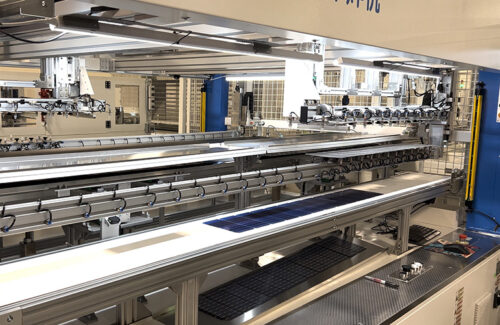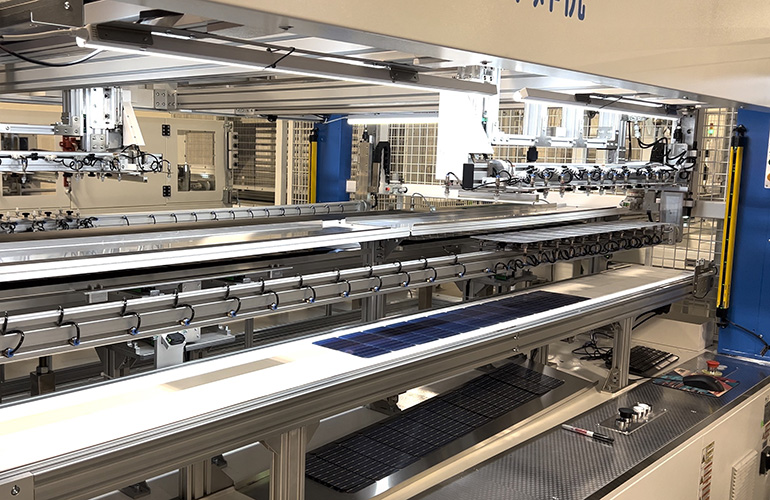
One of Heliene’s assembly lines in Mountain Iron, Minnesota.
The Inflation Reduction Act’s tax credit transferability provision has helped difficult solar projects get financed and given more entities the chance to invest in solar. Transferability is now also helping solar manufacturers build their stateside operations by maximizing 45X manufacturing credits.
The 45X Advanced Manufacturing Production Credit is offered to domestic manufacturers of eligible solar and storage components, such as panels, trackers, inverters and batteries. Barring any change to the tax code, full credits are available through December 31, 2029, after which a phasedown begins.
The upfront costs of building out domestic solar manufacturing can be daunting. The 45X credit helps make it possible, whether companies choose to wait until tax season to use it or get cash upfront through the transferability market.
“These are companies that are needing to get loans to build out their manufacturing facilities. If you can include the sale of these 45X credits in the cash flows of that solar panel manufacturer or lithium mining extraction technology, you’re helping their economic case in terms of being able to grow a business that takes significant upfront capital,” said Erik Underwood, co-founder and CEO of renewable energy tax credit marketplace Basis Climate.
Basis Climate is one of a handful of renewable energy-specific tax credit marketplaces formed after the IRA made transferability an option. These marketplaces take a small cut of the transaction to handle all behind-the-scenes work to transfer tax credits to a company or individual looking to reduce their tax liability. Credits are sold at a discount on the dollar to make it worthwhile for buyers, while giving the sellers more liquidity in the short-term.
Canadian solar panel manufacturer Heliene is just one company that has used 45X credit sale proceeds as collateral on a loan to finance the company’s working capital.
“Even if you need to discount a few pennies on the dollar, what you’re selling is always a better deal than paying interest on your money for a year and a half,” said Martin Pochtaruk, CEO of Heliene.
Heliene sold its 2023 and 2024 45X credits for $50 million to an undisclosed company and is now seeking buyers for its 2025 credits.
“The buyer for our 2023 and 2024 credits is an Ohio-based company that has hundreds of millions in tax liability. It is the first time they were buying 45X, while they’ve been buying PTCs and ITCs for a long time,” Pochtaruk said.
Inverter manufacturer SolarEdge is another company that sold its 2024 45X credits for $40 million. J.B. Lowe, head of SolarEdge investor relations, said 45X credit transfers are another way to cut corporate taxes.
“It gives tax-paying corporations the ability to offset tax liabilities. It’s interesting, in a way, that the Trump administration wants to extend a bunch of tax cuts. This type of mechanism helps corporations lower their taxes,” Lowe said.
SolarEdge also sees an advantage in selling these discounted credits ahead of time to pump more money into operations in the near-term.
“We’re a public company, and we have expenses all the time. Anytime you can get cash sooner, if you could do it in a cost-advantageous way or price-advantageous way, then it’s something to consider. It’s all about time, value of money and whether it’s worth the transaction costs and discounts to pull that cash forward rather than waiting,” Lowe said.
While Heliene and SolarEdge profited in the tens of millions of dollars from 45X sales, U.S. thin-film solar panel manufacturer First Solar facilitated the largest publicized 45X transfer sale thus far. The company sold $700 million of its credits to financial services company Fiserv for 96¢ per $1 of tax credits.
“This is the IRA delivering on its intent, which is to incentivize high-value domestic manufacturing by providing manufacturers with the liquidity they need to reinvest in growth and innovation,” said Mark Widmar, CEO of First Solar, in a press statement. “This agreement establishes an important precedent for the solar industry, confirming the marketability and value of advanced manufacturing production tax credits.”
While the companies selling 45X credits are motivated to lower their loan amounts and increase current cash on hand, those buying the credits are bolstering U.S. renewable energy manufacturing. Electronics manufacturer Schneider Electric, which makes numerous products for the residential solar market including inverters and smart meters, purchased an undisclosed amount of 45X credits from Silfab in 2024.
“45X, really, is a jobs story. It’s another way to support the downstream needs of the solar industry. We all believe in ‘Made in America,’ and we all believe in American jobs. And so how can we stand in that space and support that in order to help our clients believe in it too?” said Emily Rose, associate director of renewable energy investments at Schneider. “Schneider, I don’t think, would have bought [just] any tax credit. They really wanted to stay within the overarching sustainability culture that they live and breathe here.”
In addition to mission-driven investing, purchasing production-based tax credits like 45X also comes with less risk than investment-based credits.
“We’ve talked to plenty of buyers that say, ‘I want to support 45X credits because I like the risk profile of a production-based credit, but I also like the story of diversifying and supporting American clean energy manufacturing,’” said Basis Climate’s Underwood.
The fate of many IRA elements, including 45X, is up in the air with the new oil-and-gas-centric Trump presidency. Some members of Congress are seeking to block the 45X manufacturing credit from companies with ties to China, a task that could complicate this credit moving forward. But Schneider’s Rose believes there’s no immediate threat.
“I don’t know why transferability specifically would be taken away when it is the most free-market part of tax credits. 45X, which helps support job growth and keep the downstream supply chain within the United States, seems to me to be a really nice, protected space,” she said.
Even if laws were to change, tax transfer contracts through Basis Climate and other platforms have change-in-law clauses that allow parties to unwind transactions. Underwood believes buyers should feel comfortable purchasing tax credits this year and even begin to make plans for 2026.
“We think that buyers acting right now, who have the ability to strategize their taxes and have the ability to make commitments, should be ready to go, and they should feel comfortable doing so,” Underwood said.

